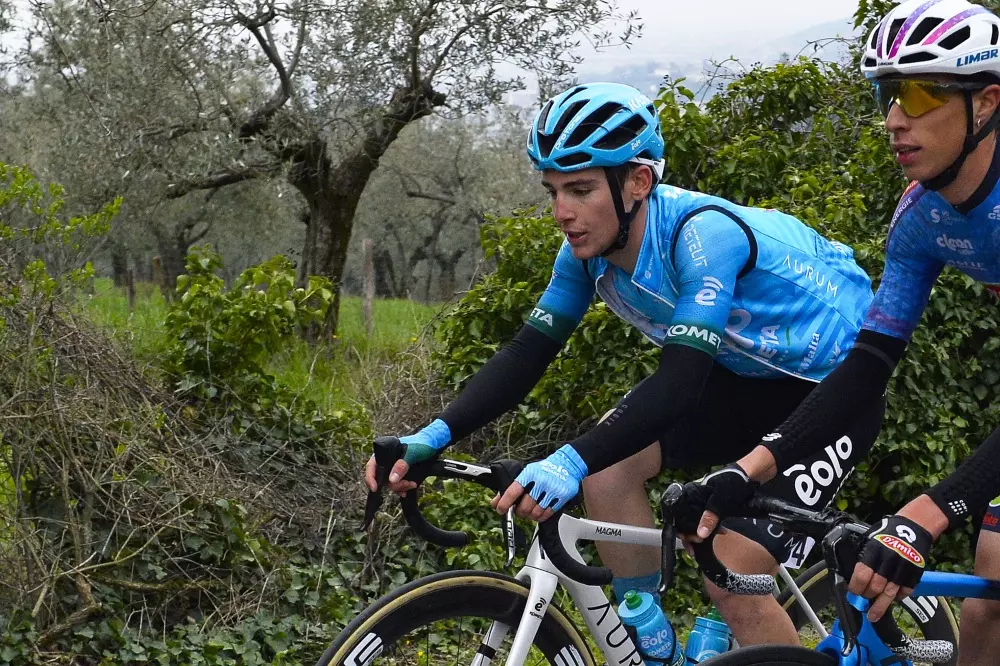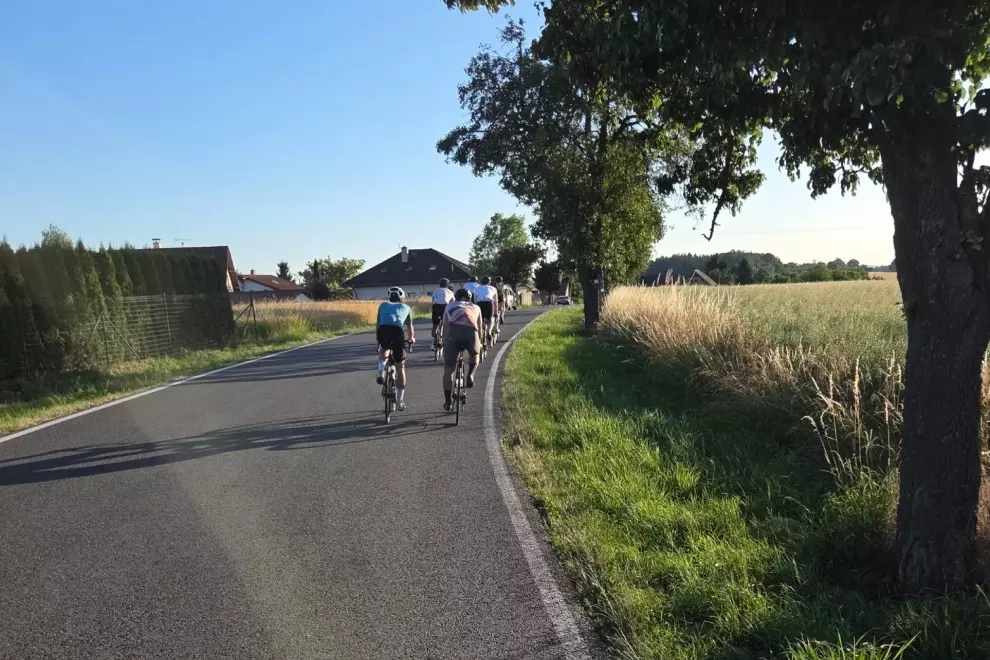First, we talked to the team Physiotherapist Roberto Puertas about how he helps riders deal with the physical demands of a long stage race.
Can you explain your role as a team physiotherapist in supporting the health and well-being of riders during a Grand Tour?
As a team physiotherapist, my primary responsibility is to maintain the riders’ health at an optimal level by paying attention to every detail. We create customized recovery protocols that we adjust daily based on each rider’s condition. During the race, we assist them at all times, from warm-up massages or bandaging on the bus before the start to post-race recovery. This may involve pressotherapy, cryotherapy, drainage or treating specific pain symptoms.
What are the most common injuries and physical issues that riders face during a multi-stage race, and how do you help prevent and treat them?
Riders commonly face two types of injuries: traumatic and non-traumatic. Traumatic injuries may result from crashes, such as broken bones like wrists, ribs or collarbones. Non-traumatic injuries are usually associated with overloads or overuse, such as tendinopathy or muscle pain. The key to addressing these issues is preventive work, ensuring proper recovery processes are in place, and utilizing tools like pressotherapy, diathermy, drainage massage, and electrotherapy to minimize the chances of injury. Prevention is always better than having to deal with the problem later.
What’s the toughest injury you helped manage for a rider during a previous race?
The most challenging situation involved managing a rider with a broken rib for over a week. We provided daily treatments in the morning and evening, including bandaging, diathermy, diaphragm treatments, and work on inspiratory muscles to reduce pain and muscle tone in the area. This was crucial to avoid excessive pressure and traction on the affected area.
Next, we asked Head Coach Carlos Barredo about how he helps riders maintain psychological health during a gruelling race like the Giro.
How do you as a sports psychologist support the performance of riders during a Grand Tour?
As a sports psychologist, I take on a dual role: an expert and a supportive teammate. The contributions of directors, physios, masseurs, and coaches are essential throughout the tour, as talking to riders helps us identify any discomfort or concerns they may have, both within and outside the race. By addressing these issues, we can redirect their focus and anticipate potential problems, ensuring a smoother experience.
What are the most common psychological challenges and pressures that riders face during a multi-stage race?
In a three-week race, cyclists often face feelings of insecurity from a physiological or psycho-physiological standpoint. Speaking as a former cyclist, there’s always some apprehension about how one’s body will cope as the days progress. Add to this the prolonged time away from home, surrounded by colleagues, staff, and a makeshift family, and riders may struggle to separate their personal lives from the race, leading to lapses in concentration. To maintain focus, riders need to develop the maturity and flexibility to shift between internal and external focus, balancing their personal lives and the ongoing competition.
Can you give an example of some techniques you use to help riders build mental resilience or maintain focus?
One strategy I frequently employ as a coach involves nurturing a reflective mindset in cyclists, not only during competitions but also at home. I believe that nutrition, training, and psychological preparation should be integrated into a rider’s routine beforehand. Encouraging a reflective mindset means that after a training session or competition, riders should analyse what they did well and what could have been better. From there, we can develop improvement strategies, implement them in training, and reassess them.
This process involves examining various aspects, such as physical performance, psychological state, pre- and post-training nutrition, and hydration. By conducting this analysis, riders can identify areas for improvement, apply corrective measures, and continually refine their skills. This cyclical feedback process ultimately contributes to the athlete’s growth.

We also had a chance to talk to the team doctor Fabian Sanchis about the common health issues he helps the riders deal with.
What are the most common medical issues that riders encounter during a multi-stage race?
In stage races, especially those that last for three weeks, it’s almost guaranteed that something will come up. Apart from problems related to falls, the most common ones are certainly upper respiratory tract infections. And they are especially frequent in cold and wet weather conditions like in this Giro d’Italia. And, of course, I can’t forget to put gastrointestinal problems on the list.
Have you ever had to recommend pulling a rider from a race for health reasons? When would you consider that option?
Absolutely, I’ve faced such a situation. The decision to advise a cyclist to withdraw from a race due to health concerns isn’t taken lightly. Typically, this would be considered when continuing in the race would exacerbate an existing issue or impair the recovery process. For instance, during multi-stage races, there might be consecutive hard stages that leave the cyclist with insufficient time to recuperate. Under such circumstances, we’d opt for the rider to not proceed further in the race.
Lastly, we had a chat with Carmine Magliaro who serves as the team chef.
What does the cooperation between you and the team’s nutritionist look like? What are the most common conflict points?
Oh, conflict points? We have none of those! The team nutritionist and I are like two peas in a pod, with one common goal: to keep the riders in top shape during stressful times. We chat and plan daily, making sure everything runs like a well-oiled machine.
What are the challenges of preparing meals in various locations throughout the race, while making sure it’s always high-quality nutrition?
It’s all about finding fresh, high-quality ingredients. Sure, moving around every day can be a bit of a headache but if you’re organized down to the tiniest detail, you can dodge most of the curveballs thrown at you.
Can you share some examples of dishes you prepare for the riders that are both nutritious and flavourful? Is there a favourite dish that everyone enjoys?
Well, my porridge has become the stuff of legends among the riders! It’s a delicious, light, and energy-packed breakfast made with oatmeal, fresh fruit, and a few special secret ingredients that my lips are sealed on!
Do you prepare snacks for riders to eat on the bike? Which are their favourites? Are the famous rice cakes popular?
Oh, absolutely! Rice cakes are a smashing hit, especially the coconut or chocolate ones. During the race, the riders also go bananas for small sandwiches stuffed with ham and spreadable cheese—easy to stash in a pocket while pedalling.
Are there any innovative cooking techniques or ingredients you have introduced to the team to improve the nutritional value or taste of your dishes?
Well, you see, years of experience with the team have given me a treasure trove of culinary secrets. For instance, the perfect rice texture for those famous “rice cakes” or the ideal yoghurt-to-porridge ratio. But like any good magician, I never reveal my tricks!






